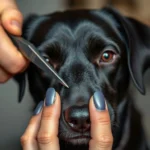
Introduction
The health of your dog’s eyes is just as important as any other aspect of their well-being. Dogs can experience various eye conditions that, if left untreated, can lead to significant discomfort or even vision loss. Eye drops for dogs are crucial in both maintaining eye health and treating existing conditions. This article will delve into the best eye drops for dogs, their uses, and how to choose the right one for your furry friend.
Understanding Dog Eye Health
Common Eye Conditions in Dogs
Eye problems in dogs can arise from numerous factors, including age, breed, and environmental conditions. Here are some of the most common eye issues:
- Conjunctivitis: This condition involves inflammation of the conjunctiva, leading to symptoms like redness, swelling, and discharge. Bacterial, viral, or allergic causes can trigger it.
- Dry Eye (Keratoconjunctivitis Sicca): Insufficient tear production causes dry eye, leading to irritation, redness, and a gooey discharge. This condition can be chronic and may require ongoing treatment.
- Cataracts: This clouding of the eye lens can lead to vision impairment and is often age-related. Symptoms may include cloudy eyes, difficulty seeing in low light, and changes in behavior.
- Glaucoma: Increased pressure within the eye can lead to pain and vision loss. Symptoms include excessive tearing, squinting, and redness.
Recognizing these symptoms early can aid in prompt treatment and care.
Importance of Regular Eye Check-ups
Regular veterinary check-ups are vital for early detection of potential eye problems. During these visits, your vet can perform thorough eye examinations to identify any issues before they escalate.
At-home eye health checks can also be beneficial. Observe your dog’s eyes for any signs of redness, swelling, or unusual discharge. If you notice anything concerning, it’s best to consult your veterinarian.
Types of Eye Drops for Dogs
Artificial Tears
Artificial tears are designed to lubricate and hydrate the eyes, making them essential for dogs suffering from dry eye or other conditions that affect tear production. These eye drops help alleviate discomfort and promote healing.
Recommended Brands:
– Optixcare: These artificial tears are veterinary-formulated and provide long-lasting moisture.
– Systane: A popular choice among pet owners, Systane offers a range of formulations suitable for dogs.
Antibiotic Eye Drops
When bacterial infections occur, antibiotic eye drops are often prescribed to combat the infection and prevent further complications. These drops can help reduce inflammation and promote healing.
Effective Options:
– Gentamicin: This antibiotic drop is effective against a variety of bacterial infections.
– Neomycin: Often combined with other medications, Neomycin helps treat infections while providing anti-inflammatory benefits.
Anti-inflammatory Eye Drops
Used primarily for conditions like allergies or post-surgery recovery, anti-inflammatory eye drops can help reduce swelling and discomfort. These drops can be particularly beneficial for dogs that have undergone eye surgery or are experiencing allergic reactions.
Common Choices:
– Prednisolone Acetate: This potent anti-inflammatory drop is often used for various eye conditions.
– Flurbiprofen: Effective for reducing inflammation and pain, especially post-operatively.
Glaucoma Medications
Glaucoma is a serious condition that requires immediate attention. Eye drops specifically designed to manage glaucoma help reduce intraocular pressure.
Key Medications:
– Timolol: This non-selective beta-blocker helps decrease eye pressure and is commonly prescribed for dogs with glaucoma.
– Dorzolamide: Another effective option, Dorzolamide works by reducing the production of fluid in the eye.
Allergy Relief Eye Drops
Dogs can suffer from allergies just like humans, and allergy relief eye drops can help alleviate symptoms such as redness and itching.
Recommended Options:
– Ketotifen: An effective antihistamine that can help relieve allergic conjunctivitis.
– Olopatadine: This is another antihistamine option, often used for seasonal allergies.
Choosing the Best Eye Drops for Your Dog
Consult Your Veterinarian
Before starting any treatment, consulting your veterinarian is essential. They can provide a proper diagnosis and recommend the most suitable eye drops for your dog’s specific condition.
When speaking with your vet, consider asking the following questions:
– What type of eye condition does my dog have?
– How often should I administer the eye drops?
– Are there any side effects I should be aware of?
Factors to Consider
When selecting eye drops, consider your dog’s age, breed, and any underlying health conditions. These factors can significantly influence which drops are most appropriate.
Additionally, pay attention to the ingredients in the eye drops. Some dogs may have sensitivities to specific components, so choosing a product with safe, effective ingredients is essential.
Reading Labels and Ingredients
Understanding the ingredients in any eye drops you consider is crucial. Here are some common ingredients and their purposes:
– Artificial tears: Provide lubrication and hydration.
– Antibiotics: Combat bacterial infections.
– Anti-inflammatory agents: Reduce swelling and discomfort.
Be vigilant about avoiding harmful substances like corticosteroids unless prescribed by a veterinarian, as they can worsen certain eye conditions.
Administering Eye Drops to Dogs
Preparation Before Administration
Before administering eye drops, gather all necessary supplies, including the drops, a clean cloth, and treats for positive reinforcement. Make sure to calm your dog, as a relaxed pet is easier to handle during the process.
Step-by-Step Guide to Administering Eye Drops
-
Position Your Dog: Have your dog sit or lie down in a comfortable position. If they are nervous, consider having someone gently hold them.
-
Wash Your Hands: Clean hands are crucial to prevent any contamination of the eye drops.
-
Administer the Drops: Hold the dropper above your dog’s eye, ensuring it doesn’t touch the eye or fur. Squeeze the dropper gently to release the recommended number of drops.
-
Encourage Blinking: Gently stroke your dog’s face to encourage blinking, which helps distribute the medication.
-
Reward Your Dog: After administering the drops, reward your dog with treats and praise to create a positive association.
Post-Administration Care
After giving your dog eye drops, monitor them closely for any adverse reactions, such as excessive tearing or signs of discomfort. If any unusual symptoms arise, contact your veterinarian immediately.
Home Remedies and Preventative Care
Natural Remedies for Eye Care
For minor irritations, some pet owners prefer natural remedies. Here are a few safe options:
– Warm compresses: Applying a warm, damp cloth can help soothe irritation.
– Chamomile tea: A cooled chamomile tea bag can be used as a compress to reduce inflammation.
However, it’s crucial to consult your veterinarian before using any home remedies, especially if your dog has a known eye condition.
Preventative Measures for Eye Health
Maintaining your dog’s eye health goes beyond treatment; proactive care is equally important. Here are some best practices:
– Regular grooming: Keeping your dog’s fur trimmed around the eyes can prevent irritation.
– Balanced diet: A nutritious diet rich in vitamins A, C, and E supports overall eye health.
– Routine vet visits: Regular check-ups can help detect potential issues early.
Conclusion
Maintaining your dog’s eye health is crucial for their overall well-being. Understanding the best eye drops for dogs and learning how to care for their eyes can significantly impact their quality of life. By staying proactive and consulting your veterinarian, you can ensure your furry friend enjoys clear vision and comfort for years to come. Always remember that your dog’s health is a priority, and timely interventions can make a world of difference.









